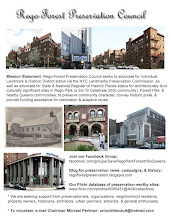Please take a few minutes to help preserve the historic Forest Hills Tennis Stadium, an IMMINENTLY ENDANGERED AMERICAN & INTERNATIONAL ICON.
 |
| Classic postcard of a classic! LANDMARK or the dumpster? |
The Problem....
Remember the 1963 demolition of Penn Station as New Yorkers watched in awe? You may be too young, but you get the picture. That led to the establishment of the Landmarks Law in 1965, to prevent further demolition of our landmarks that read NY all over it. The difference here is that the Forest Hills Tennis Stadium reads more than NY! After a vote on August 19th by a percentage of West Side Tennis Club members with voting rights, the historic Forest Hills Tennis Stadium may be sold to a developer, who will likely demolish it for a residential development. The greater public, who the Stadium was built for, will be excluded from the voting process. Wouldn't it be wise and more reputable for the WSTC to keep the Stadium or sell it to a reputable developer who will value, restore, & adaptively reuse an International icon? Will this be Queens' Penn Station? Whether you are or aren't a WSTC member, there are ways that the "greater public" can still take action to defend an ICON!
Lookout below for 2 urgent routes towards preservation
~ OR~
A prime facet of history will be gone forever!
Forest Hills Tennis Stadium Significance....
The Forest Hills Tennis Stadium is truly an American & International icon in terms of tennis, musically, and architecturally. It was the first concrete stadium of its type in the country, and was referred to as the "World Capital of Tennis." Some prominent tennis players included Bill Tilden, Helen Wills, Althea Gibson, and Arthur Ashe. The facade is embellished with eagles, shields bearing the West Side Tennis Club logo, and grand historic archways. It was the home to the U.S. Open, singles championships, Wrightman Cup, Davis Cup, and a number of firsts in tennis history. It was also home to music festivals starring Frank Sinatra, The Beatles, Simon & Garfunkel, Diana Ross, Judy Garland, Trini Lopez, The Who, Barbra Streisand, Johnny Mathis, The Monkees, etc. A key scene in "Strangers On A Train" (1951) by Alfred Hitchcock took place at the Stadium. The Tudor Clubhouse dates to 1913 (Famed Architect Grosvenor Atterbury & John Almay Tompkins), and the Forest Hills Tennis Stadium dates to 1923 (Famed Architect Kenneth M. Murchison). The West Side Tennis Club helped establish the sport of tennis in the U.S. Forest Hills is known for tennis, and tennis is known for Forest Hills. Sadly, the West Side Tennis Club has neglected an icon, letting it sit somewhat abandoned, after the U.S. Open needed a larger space than 14,000 seats in the late 70s, and the WSTC did not promote it as much for music festivals or smaller matches. Photos, memorabilia, history:
ROUTE #1 - HOW YOU CAN HELP PRESERVE AN ICON:
Based on the above significance and your own sentiments, please write a letter supporting landmark status to the NYC Landmarks Preservation Commission. The Forest Hills Tennis Stadium, Clubhouse, interiors, and grounds should be calendared for a public hearing ASAP. If restored and adaptively reused for smaller concerts and smaller tennis matches, it would enhance the appeal of the neighborhood, and preserve a historic icon. Jet Blue can be a sponsor. Breathable space is prime, and we do not need typical condos in a neighborhood accustomed to overdevelopment. City Landmarking will preserve the historic Forest Hills Tennis Stadium, Clubhouse, grounds, & interiors for future generations to cherish, increase the chances of funding for repairs, and ultimately enhance our quality of life.
Please e-mail the Landmarks Preservation Commission a letter requesting landmark status ASAP. It can be brief, yet meaningful.
CONTACT:
- LPC Chair Robert Tierney: rtierney@lpc.nyc.gov
- LPC Dir of Research Mary Beth Betts: mbetts@lpc.nyc.gov
- LPC General mailbox: comments@lpc.nyc.gov
- LPC Exec. Dir. Kate Daly: kdaly@lpc.nyc.gov
- Rego-Forest Preservation Council Chair Michael Perlman: unlockthevault@hotmail.com
- LPC Chair Robert Tierney: rtierney@lpc.nyc.gov
- LPC Dir of Research Mary Beth Betts: mbetts@lpc.nyc.gov
- LPC General mailbox: comments@lpc.nyc.gov
- LPC Exec. Dir. Kate Daly: kdaly@lpc.nyc.gov
- Rego-Forest Preservation Council Chair Michael Perlman: unlockthevault@hotmail.com
ROUTE #2 - HOW YOU CAN HELP PRESERVE AN ICON:
Inform any contacts (members) that you know of at the Forest Hills Tennis Stadium to vote against the plan to sell the historic Stadium to a developer, who will very likely demolish it for a condo. Keep in mind that the vote to sell the stadium is slated for August 19th, which follows the informational meeting at the West Side Tennis Club (1 Tennis Place, Forest Hills, NY) on August 10th.
Please help by composing a brief letter to the Landmarks Preservation Commission, and also forward this preservation campaign posting to all your contacts. Time is of the essence!
Thank you,
- Michael Perlman
Rego-Forest Preservation Council, Chair
unlockthevault@hotmail.com
 |
| The Stadium hosted annual music festivals, attracting thousands. Still have those ticket stubs? |
 |
| Althea Gibson: 1st African American woman to be a competitor on the world tennis tour, & 1st to win a Grand Slam title in '56. |
 |
| Vintage magazine explains how the Forest Hills Tennis Stadium is the heart of the West Side Tennis Club! |






